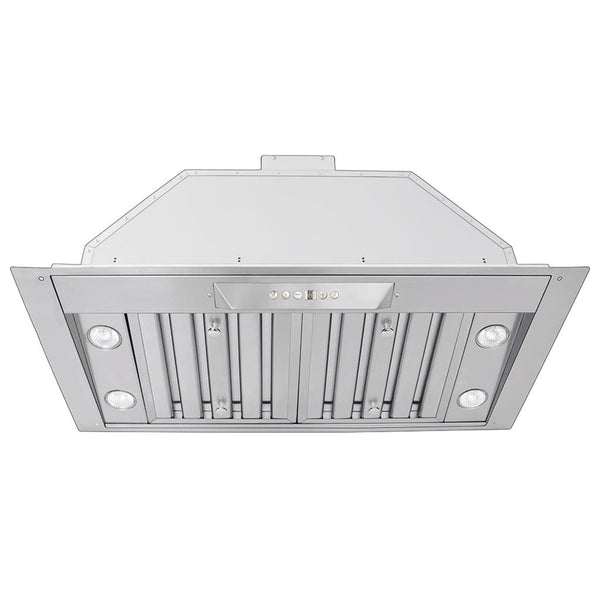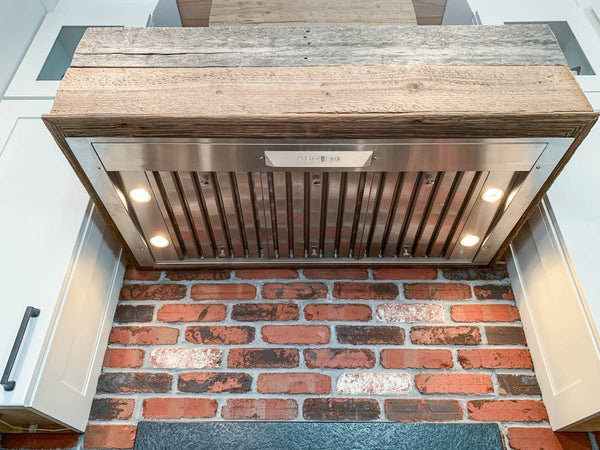Table of Contents
Proline offers an extensive lineup of these ventilation hoods, from sleek under-cabinet models to statement-making island hoods that work without a single duct in sight.
Breaking Down: What are Ductless Range Hoods?
A ductless range hood is a ventilation appliance that operates on the principle of air recirculation rather than air evacuation. Here's the process:
Step 1: Air Intake
The hood's fan creates negative pressure, drawing contaminated air upward at a rate measured in Cubic Feet per Minute (CFM).
Step 2: Filtration Phase
The contaminated air passes through two filtration stages:
- Primary mechanical filtration (grease and particulate removal)
- Secondary chemical filtration (odor absorption via activated carbon)
Step 3: Air Return
The filtered air is redistributed into the kitchen environment through designated vents.
What are Ductless Range Hood Set Ups Best For?
Structural Limitations
- Multi-story residential buildings without existing ventilation infrastructure
- Historic/Old structures where modifications are restricted or not possible
- Interior kitchen locations without exterior wall access
- Rental properties where permanent modifications are prohibited
Pros and Cons of Ductless Range Hoods
Advantages
Installation Efficiency
Lower/easier Installation time
Basic household tools needed
Zero structural modification
Optional professional installation (Read more on how to install your ductless range hood here)
Cost Differential
Ductless hoods cost significantly less than a ducted hood.
Operational Flexibility
100% portable relocation
Noise levels: 45-65 decibels (comparable to normal conversation)
Variable speed options: Typically 3-6 settings
Maintenance Accessibility
Easy filter access ~ you will need to change your charcoal filters after 30 hours of cooking
Replacement parts ~ Just call in and we can help you
Disadvantages
Performance Metrics
Particulate removal: Filters remove approximately 30% of PM2.5 particles
NO2 removal: New carbon filters start at 60% efficiency but degrade to 20% after less than 3 weeks of regular use
Moisture removal: 0% (moisture remains in kitchen environment)
Heat removal: Limited to ambient air circulation only
Capture efficiency: Varies by hood design and burner location (30-40% for front burners, up to 90% for back burners)
Operational Costs
Filter replacement: $40-100 after 30 hours of cooking operation
Reduced filter efficiency over time: 10-15% degradation monthly
Electricity consumption: Similar to ducted (150-300 watts)
Cleaning supplies: $20-30 annually
Proline Popular Ductless Range Hoods
Conclusion: The Ductless Ventilation Verdict
Based on our analysis, ductless range hoods represent a good ventilation solution for many residential cooking applications. The technology, while not achieving the complete evacuation of ducted systems, provides filtration that many users find adequate for normal cooking activities when properly sized and maintained.
The Proline ductless range hoods meets or exceeds industry standards for residential kitchen ventilation, providing CFM ratings from 600-1000 and utilizing proven filtration technologies.
Ready to explore ductless range hood options for your kitchen? Browse our complete collection of ventilation solutions that work without external venting.
Shop Ductless Range HoodsCitations:
Particulate removal (30% PM2.5): Jacobs, P. and Cornelissen, H.J.M. "Efficiency of recirculation hoods with regard to PM2.5 and NO2." ResearchGate, July 1, 2017. Study states: "With the carbon filter PM2.5 is reduced for about 30%."
NO2 removal (60% degrading to 20%): Jacobs, P. and Cornelissen, H.J.M. "Efficiency of recirculation hoods with regard to PM2.5 and NO2." ResearchGate, July 1, 2017. Study states: "A fresh carbon filter removed about 60% of the NO2, dropping within a few weeks of cooking to 20%." The study specified this degradation occurred after "simulating 19 days of cooking (20 minutes/day 5 kW)."
Moisture removal (0%): Irwin, Kristof. "Recirculating Hoods and Indoor-Air Quality." Fine Homebuilding, September 25, 2024. Article states: "Recirculating hoods neither remove moisture from the air" and "In neither case are particles or moisture removed from the air."
Heat removal (limited to circulation): This is a statement of physical fact about recirculating systems - they only move air within the space rather than exhausting it. No specific citation needed as this is the fundamental difference between ducted and ductless systems.
Capture efficiency (30-40% front burners, 90% back burners): "SUPPLEMENT 2: Criteria for Selecting an Effective Ducted Range Hood." ROCIS (Reducing Outdoor Contaminants in Indoor Spaces), May 23, 2024. States: "According to Lawrence Berkeley National Laboratory (LBNL) the capture efficiency of standard hoods is typically in the range of 30-40% on front burners and can be as high as 90% on back burners."



















